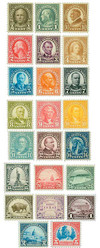
# 551-73 - 1922-25 Flat Plate Printing perf 11, Complete Set of 23 Stamps
The Last Flat Plate-Printed
U.S Stamp Series
The Series of 1922-25 set includes the last 23 mint stamps printed by the flat plate press. You’ll want this set for your collection, as it represents the end of the early era of stamp printing, paving the way for the rotary press.
Set includes sought-after U.S. #573. Only 543,329 “America” stamps were issued, and many were used on postage, making this an especially scarce stamp.
Other stamps in the set honor important Americans, such as Nathan Hale. During the American Revolution, Hale served as a soldier in the Continental Army and spied on the British. He was eventually captured and executed, but his famous last words, “I only regret that I have but one life to give for my country,” have inspired Americans for over two centuries.
Now’s your chance to fill the gaps in your collection with one convenient, money-saving order – get it now.
Start Of Modern FDC Collecting
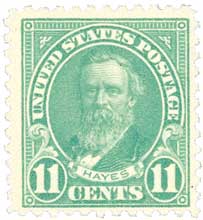
On October 4, 1922, an 11¢ Hayes stamp was issued on a specific date in a specific city for the first time. Many consider this to be the start of modern First Day Cover Collecting.
Prior to this event, the Post Office Department didn’t often designate specific dates for the issue of new stamps. Only a few had a set first day of issue, and most of those were commemoratives. There were some first day covers as early as 1851, but they were not specifically prepared like the First Day Covers we know today.
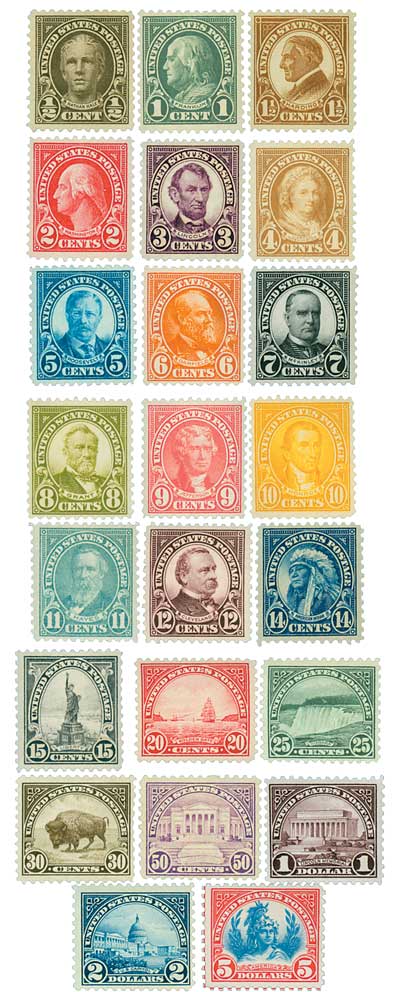
A major step in the evolution of First Day Covers came in 1922. Then-Assistant Postmaster General W. Irving Glover announced that “henceforth every new stamp issued will have a designated first day of issue.” The first stamp issued under this new policy was #E12, the 10¢ Special Delivery stamp, on July 12, 1922, in Washington, DC.
During this time, the Post Office had also begun plans on a new series of definitive stamps, the Series of 1922, also known as the Fourth Bureau Issue. The stamps were to replace the Washington-Franklins, which had been in use since 1908. Part of the reason for the new series was to help postal workers, who had difficulty quickly identifying the face-same Washington-Franklin stamps.
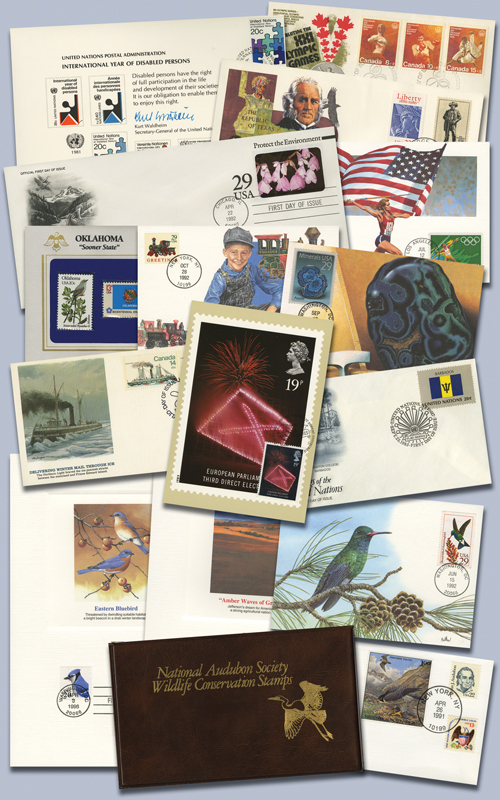
The new series would honor several presidents and prominent Americans as well as notable American sites and scenes. This would also be the last series of stamps printed on the flat plate press as the post office switched to the rotary press.
The Post Office spent several months debating the honorees for the new series and ultimately decided the first stamp would honor President Rutherford B. Hayes. As 1922 marked his 100th birthday, they wanted to issue the stamp on his birthday in his hometown. To meet that schedule, the Bureau of Engraving and Printing had to rush to print the stamp. The die wasn’t finished until September 28, and the stamps went to press on September 30, the same day the first plate was approved. A limited number of stamps were in the first printing – less than a quarter of a million.
On October 4, 1922, the stamp was issued in a small ceremony in Fremont, Ohio, where Hayes was born. While the Special Delivery stamp issued earlier in the year had been issued on a pre-determined date, the Hayes stamp was the first issued in a city with a special connection to the stamp under the Post Office’s new rule. It was also the first public First Day Ceremony and the first with a mimeographed program. During the ceremony, the “first sheet” was sold to Scott Hayes, the son of the former President.
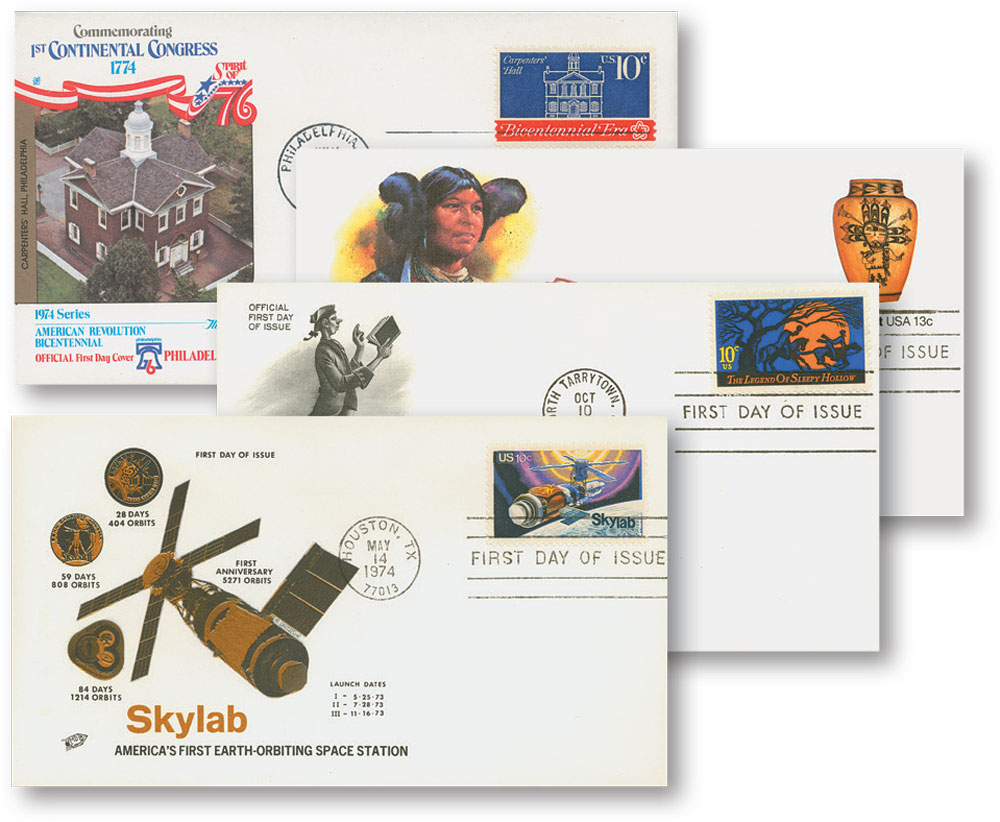
Many collectors consider the Hayes stamp to mark the start of modern First Day Cover collecting. For these early issues, collectors would need to know the issue date to identify them as first day covers. It wasn’t until 1937 that the words “First Day of Issue” were added to cancels to make identifying FDCs easier.
The Last Flat Plate-Printed
U.S Stamp Series
The Series of 1922-25 set includes the last 23 mint stamps printed by the flat plate press. You’ll want this set for your collection, as it represents the end of the early era of stamp printing, paving the way for the rotary press.
Set includes sought-after U.S. #573. Only 543,329 “America” stamps were issued, and many were used on postage, making this an especially scarce stamp.
Other stamps in the set honor important Americans, such as Nathan Hale. During the American Revolution, Hale served as a soldier in the Continental Army and spied on the British. He was eventually captured and executed, but his famous last words, “I only regret that I have but one life to give for my country,” have inspired Americans for over two centuries.
Now’s your chance to fill the gaps in your collection with one convenient, money-saving order – get it now.
Start Of Modern FDC Collecting

On October 4, 1922, an 11¢ Hayes stamp was issued on a specific date in a specific city for the first time. Many consider this to be the start of modern First Day Cover Collecting.
Prior to this event, the Post Office Department didn’t often designate specific dates for the issue of new stamps. Only a few had a set first day of issue, and most of those were commemoratives. There were some first day covers as early as 1851, but they were not specifically prepared like the First Day Covers we know today.

A major step in the evolution of First Day Covers came in 1922. Then-Assistant Postmaster General W. Irving Glover announced that “henceforth every new stamp issued will have a designated first day of issue.” The first stamp issued under this new policy was #E12, the 10¢ Special Delivery stamp, on July 12, 1922, in Washington, DC.
During this time, the Post Office had also begun plans on a new series of definitive stamps, the Series of 1922, also known as the Fourth Bureau Issue. The stamps were to replace the Washington-Franklins, which had been in use since 1908. Part of the reason for the new series was to help postal workers, who had difficulty quickly identifying the face-same Washington-Franklin stamps.

The new series would honor several presidents and prominent Americans as well as notable American sites and scenes. This would also be the last series of stamps printed on the flat plate press as the post office switched to the rotary press.
The Post Office spent several months debating the honorees for the new series and ultimately decided the first stamp would honor President Rutherford B. Hayes. As 1922 marked his 100th birthday, they wanted to issue the stamp on his birthday in his hometown. To meet that schedule, the Bureau of Engraving and Printing had to rush to print the stamp. The die wasn’t finished until September 28, and the stamps went to press on September 30, the same day the first plate was approved. A limited number of stamps were in the first printing – less than a quarter of a million.
On October 4, 1922, the stamp was issued in a small ceremony in Fremont, Ohio, where Hayes was born. While the Special Delivery stamp issued earlier in the year had been issued on a pre-determined date, the Hayes stamp was the first issued in a city with a special connection to the stamp under the Post Office’s new rule. It was also the first public First Day Ceremony and the first with a mimeographed program. During the ceremony, the “first sheet” was sold to Scott Hayes, the son of the former President.

Many collectors consider the Hayes stamp to mark the start of modern First Day Cover collecting. For these early issues, collectors would need to know the issue date to identify them as first day covers. It wasn’t until 1937 that the words “First Day of Issue” were added to cancels to make identifying FDCs easier.



